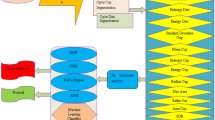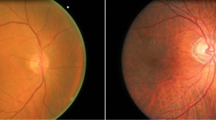Abstract
Diagnosis of Glaucoma eye disease is a challenging task for CADx (computer-aided diagnostics) systems. An automatic CADx framework is developed for diagnosing glaucoma eye disease by handcrafted feature-based segmentation in retinal images. In this manuscript, automatic glaucoma eye disease detection based on deep learning (DL), with deep-belief network (DBN) is proposed. In addition, a contextualizing DL structure is proposed for obtaining various levels of portraying fundus images to separate among glaucoma and non-glaucoma modes, where the network uses output of other CNNs as information of context to support performance. The3 existing machine learning models are (1) SVM (support vector machine) (2) RF (random forest)(3) k-NN (k-nearest neighbor), which is executed and assessed on tests. The efficiency of the Glaucoma-Deep model is analyzed by the statistical measures like sensitivity, specificity, accuracy, precision. Finally, an official conclusion executed through the softmax straight classifier is to divide glaucoma and non-glaucoma retinal fundus images.





Similar content being viewed by others
References
Abdel Maksoud E, Ramadan M, Barakat S, Elmogy M (2019) A computer-aided diagnoses system for detecting multiple ocular diseases using color retinal fundus images. Machine learning in bio-signal analysis and diagnostic imaging 19-52. https://doi.org/10.1016/b978-0-12-816086-2.00002-3
Acharya U, Ng E, Eugene L et al (2015) Decision support system for the glaucoma using Gabor transformation. Biomedical Signal Process Control 15:18–26. https://doi.org/10.1016/j.bspc.2014.09.004
Acharya U, Bhat S, Koh J et al (2017) A novel algorithm to detect glaucoma risk using texton and local configuration pattern features extracted from fundus images. Comput Biol Med 88:72–83. https://doi.org/10.1016/j.compbiomed.2017.06.022
Araújo J, Souza J, Neto O et al (2018) Glaucoma diagnosis in fundus eye images using diversity indexes. Multimed Tools Appl 78:12987–13004. https://doi.org/10.1007/s11042-018-6429-z
Asaoka R, Murata H, Hirasawa K, Fujino Y, Matsuura M, Miki A, Kanamoto T, Ikeda Y, Mori K, Iwase A, Shoji N, Inoue K, Yamagami J, Araie M (2019) Using deep learning and transfer learning to accurately diagnose early-onset Glaucoma from macular optical coherence tomography images. Am J Ophthalmol 198:136–145. https://doi.org/10.1016/j.ajo.2018.10.007
Bechar M, Settouti N, Barra V, Chikh M (2017) Semi-supervised superpixel classification for medical images segmentation: application to detection of glaucoma disease. Multidim Syst Sign Process 29:979–998. https://doi.org/10.1007/s11045-017-0483-y
Butt N, Ayub M, Ali M (2016) Challenges in the management of glaucoma in developing countries. Taiwan J Ophthalmol 6:119–122. https://doi.org/10.1016/j.tjo.2016.01.004
Chandrawati R, Chang J, Reina-Torres E et al (2017) Localized and controlled delivery of nitric oxide to the conventional outflow pathway via enzyme biocatalysis: toward therapy for Glaucoma. Adv Mater 29:1604932. https://doi.org/10.1002/adma.201604932
de Sousa J, de Paiva A, Sousa de Almeida J et al (2017) Texture based on geostatistic for glaucoma diagnosis from fundus eye image. Multimed Tools Appl 76:19173–19190. https://doi.org/10.1007/s11042-017-4608-y
Devasia T, Jacob K, Thomas T (2018) Automatic early stage Glaucoma detection using cascade correlation neural network. Smart Intell Comput Appl:659–669. https://doi.org/10.1007/978-981-13-1921-1_64
Dong Z, Wollstein G, Wang B, Schuman J (2017) Adaptive optics optical coherence tomography in glaucoma. Prog Retin Eye Res 57:76–88. https://doi.org/10.1016/j.preteyeres.2016.11.001
Ekinci G, Calikoglu A, Solak S et al (2017) Split-ring resonator-based sensors on flexible substrates for glaucoma monitoring. Sensors Actuators A Phys 268:32–37. https://doi.org/10.1016/j.sna.2017.10.054
Elseid A, Arwa O, Gasm A et al (2018) Glaucoma detection based on shape features and SMOTE algorithm. CiiT Int J Digit Image Process 10:10–60. https://doi.org/10.4258/hir.2018.24.1.53
Faust O, Acharya U, Sudarshan V et al (2017) Computer aided diagnosis of coronary artery disease, myocardial infarction and carotid atherosclerosis using ultrasound images: a review. PhysicaMedica 33:1–15. https://doi.org/10.1016/j.ejmp.2016.12.005
Fu H, Xu Y, Lin S, Zhang X, Wong DWK, Liu J, Frangi AF, Baskaran M, Aung T (2017) Segmentation and quantification for angle-closure Glaucoma assessment in anterior segment OCT. IEEE Trans Med Imaging 36:1930–1938. https://doi.org/10.1109/tmi.2017.2703147
Gour N, Khanna P (2019) Automated glaucoma detection using GIST and pyramid histogram of oriented gradients (PHOG) descriptors. Pattern Recogn Lett 137:3–11. https://doi.org/10.1016/j.patrec.2019.04.004
Guo L, Yang J, Peng L et al (2015) A computer-aided healthcare system for cataract classification and grading based on fundus image analysis. Comput Ind 69:72–80. https://doi.org/10.1016/j.compind.2014.09.005
Guo J, Azzopardi G, Shi C, Jansonius NM, Petkov N (2019) Automatic determination of vertical cup-to-disc ratio in retinal fundus images for Glaucoma screening. IEEE Access 7:8527–8541. https://doi.org/10.1109/access.2018.2890544
Gupta D, Asrani S (2016) Macular thickness analysis for glaucoma diagnosis and management. Taiwan J Ophthalmol 6:3–7. https://doi.org/10.1016/j.tjo.2016.01.003
Hagiwara Y, Koh J, Tan J et al (2018) Computer-aided diagnosis of glaucoma using fundus images: a review. Comput Methods Prog Biomed 165:1–12. https://doi.org/10.1016/j.cmpb.2018.07.012
High-Resolution Fundus (HRF) (n.d.) Image Database. https://www5.cs.fau.de/research/data/fundus-images/. Accessed date: 2/1/2016
Issac A, ParthaSarathi M, Dutta M (2015) An adaptive threshold based image processing technique for improved glaucoma detection and classification. Comput Methods Prog Biomed 122:229–244. https://doi.org/10.1016/j.cmpb.2015.08.002
Juneja M, Singh S, Agarwal N, Bali S, Gupta S, Thakur N, Jindal P (2019) Automated detection of Glaucoma using deep learning convolution network (G-net). Multimed Tools Appl 79(21–22):15531–15553. https://doi.org/10.1007/s11042-019-7460-4
Kavya N, Padmaja K (2017) Glaucoma detection using texture features extraction. 2017 51st Asilomar Conference on Signals, Systems, and Computers https://doi.org/10.1109/acssc.2017.8335600
Koh J, Acharya U, Hagiwara Y et al (2017) Diagnosis of retinal health in digital fundus images using continuous wavelet transform (CWT) and entropies. Comput Biol Med 84:89–97. https://doi.org/10.1016/j.compbiomed.2017.03.008
Lavinsky F, Wollstein G, Tauber J, Schuman J (2017) The future of imaging in detecting Glaucoma progression. Ophthalmology 124:S76–S82. https://doi.org/10.1016/j.ophtha.2017.10.011
Lee W, Kim Y, Park K, Jeoung J (2017) Trend-based analysis of ganglion cell–inner plexiform layer thickness changes on optical coherence tomography in Glaucoma progression. Ophthalmology 124:1383–1391. https://doi.org/10.1016/j.ophtha.2017.03.013
Maheshwari S, Kanhangad V, Pachori R et al (2019) Automated glaucoma diagnosis using bit-plane slicing and local binary pattern techniques. Comput Biol Med 105:72–80. https://doi.org/10.1016/j.compbiomed.2018.11.028
Mahiba C, Jayachandran A (2019) Severity analysis of diabetic retinopathy in retinal images using hybrid structure descriptor and modified CNNs. Measurement 135:762–767. https://doi.org/10.1016/j.measurement.2018.12.032
Mohamed N, Zulkifley M, Zaki W, Hussain A (2019) An automated glaucoma screening system using cup-to-disc ratio via simple linear iterative clustering superpixel approach. Biomedical Signal Processing and Control 53:101454. https://doi.org/10.1016/j.bspc.2019.01.003
Mvoulana A, Kachouri R, Akil M (2019) Fully automated method for glaucoma screening using robust optic nerve head detection and unsupervised segmentation based cup-to-disc ratio computation in retinal fundus images. Comput Med Imaging Graph 77:101643. https://doi.org/10.1016/j.compmedimag.2019.101643
Mythili S, Thiyagarajah K, Rajesh P, Shajin FH (2020) Ideal position and size selection of unified power flow controllers (UPFCs) to upgrade the dynamic stability of systems: an antlion optimiser and invasive weed optimisation algorithm. HKIE Trans 27:25–37. https://doi.org/10.33430/V27N1THIE-2018-0024
Ohlemacher S, Sridhar A, Xiao Y et al (2016) Stepwise differentiation of retinal ganglion cells from human pluripotent stem cells enables analysis of glaucomatous neurodegeneration. Stem Cells 34:1553–1562. https://doi.org/10.1002/stem.2356
Perdomo O, Andrearczyk V, Meriaudeau F et al. (2018) Glaucoma diagnosis from eye fundus images based on deep morphometric feature estimation computational pathology and ophthalmic medical image analysis 319-327. https://doi.org/10.1007/978-3-030-00949-6_38
Raghavendra U, Fujita H, Bhandary S et al (2018) Deep convolution neural network for accurate diagnosis of glaucoma using digital fundus images. Inf Sci 441:41–49. https://doi.org/10.1016/j.ins.2018.01.051
Raghavendra U, Bhandary S, Gudigar A, Acharya U (2018) Novel expert system for glaucoma identification using non-parametric spatial envelope energy spectrum with fundus images. Biocybernetics Biomed Eng 38:170–180. https://doi.org/10.1016/j.bbe.2017.11.002
Raghavendra U, Gudigar A, Bhandary S et al (2019) A two layer sparse autoencoder for Glaucoma identification with fundus images. J Med Syst 43:299. https://doi.org/10.1007/s10916-019-1427-x
Saba T, Bokhari S, Sharif M et al (2018) Fundus image classification methods for the detection of glaucoma: a review. Microsc Res Tech 81:1105–1121. https://doi.org/10.1002/jemt.23094
Sarathi M, Dutta M, Singh A, Travieso C (2016) Blood vessel inpainting based technique for efficient localization and segmentation of optic disc in digital fundus images. Biomed Signal Process Control 25:108–117. https://doi.org/10.1016/j.bspc.2015.10.012
Serener A, Serte S (2019) Transfer learning for early and advanced Glaucoma detection with convolutional neural networks. 2019 Medical Technologies congress (TIPTEKNO). https://doi.org/10.1109/tiptekno.2019.8894965
Sevastopolsky A (2017) Optic disc and cup segmentation methods for glaucoma detection with modification of U-net convolutional neural network. Pattern Recognit Image Anal 27:618–624. https://doi.org/10.1134/s1054661817030269
Shi Y, Marion K, Jenkins D et al (2019) Identification and characterization of imaging technique errors and artifacts using anterior-segment OCT for Irido-corneal angle evaluations in Glaucoma. Ophthalmol Glaucoma 2:136–144. https://doi.org/10.1016/j.ogla.2019.02.006
Shinoj VK, Hong XJ, Murukeshan VM, Baskaran M, Tin A (2016) Progress in anterior chamber angle imaging for glaucoma risk prediction – a review on clinical equipment, practice and research. Med Eng Phys 38:1383–1391. https://doi.org/10.1016/j.medengphy.2016.09.014
Sjchoi86-HRF dataset (n.d.): https://github.com/sjchoi86/retina_dataset/tree/master/dataset. Access date: 26/1/2017
Soorya M, Issac A, Dutta M (2019) Automated framework for screening of Glaucoma through cloud computing. J Med Syst 43:136. https://doi.org/10.1007/s10916-019-1260-2
Transpire Online (2019) A novel numerical optimization algorithm inspired from particles: particle swarm optimization, transpire Online 2019. Available at: https://transpireonline.blog/2019/07/03/a-novel-numerical-optimization-algorithm-inspired-from-particles-particle-swarm-optimization/. Accessed on: Sep 2019
Yu S, Xiao D, Frost S, Kanagasingam Y (2019) Robust optic disc and cup segmentation with deep learning for glaucoma detection. Comput Med Imaging Graph 74:61–71. https://doi.org/10.1016/j.compmedimag.2019.02.005
Zilly J, Buhmann J, Mahapatra D (2017) Glaucoma detection using entropy sampling and ensemble learning for automatic optic cup and disc segmentation. Comput Med Imaging Graph 55:28–41. https://doi.org/10.1016/j.compmedimag.2016.07.012
Author information
Authors and Affiliations
Corresponding author
Additional information
Publisher’s note
Springer Nature remains neutral with regard to jurisdictional claims in published maps and institutional affiliations.
Rights and permissions
About this article
Cite this article
Patil, N., Patil, P.N. & Rao, P.V. Convolution neural network and deep-belief network (DBN) based automatic detection and diagnosis of Glaucoma. Multimed Tools Appl 80, 29481–29495 (2021). https://doi.org/10.1007/s11042-021-11087-5
Received:
Revised:
Accepted:
Published:
Issue Date:
DOI: https://doi.org/10.1007/s11042-021-11087-5




